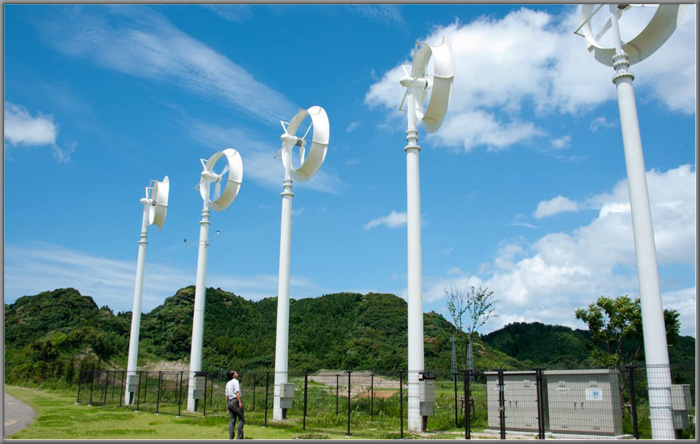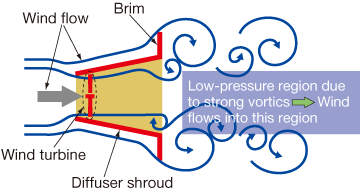Home > Highlighting JAPAN > Highlighting Japan JULY 2011 > Second Wind
Highlighting JAPAN
COVER STORY: Embracing New Energy
Caption: Wind Lenses on the Ito Campus of Kyushu University
Credit: MASATOSHI SAKAMOTO
Second Wind

Wind Lens Mechanism
Electricity generated using a wind turbine is proportional to the cube of wind velocity. You can increase electricity generation dramatically if you can increase the speed of the wind and concentrate the wind energy in a small area, using the hydrodynamic features of a structure, just as hydroelectric power generation concentrates the energy of water using a dam. Professor Ohya focused on that point.
"If you make the diffuser shroud longer, wind velocity becomes greater near the entrance to the equipment. However, in this case the wind power generation equipment becomes larger, and production costs rise," said Professor Ohya. "So I looked for a way to increase wind velocity with a short diffuser. I attached a part that will create vortices, called a brim, around the exit of the diffuser. The attachment of the brim defied conventional wisdom about wind power generation, which posited that there should be no obstacles in the way of the wind."
The brim around the wind turbine generates strong vortices with a low-pressure area beyond them. Wind flows into the low-pressure area, and wind velocity increases dramatically near the entrance of the diffuser. That is the basic mechanism of the Wind Lens.
At present, twenty-five Wind Lenses are being trialed in Fukuoka Prefecture, home to Kyushu University. They are generating electricity as expected. As a first step for creating high-density power generation farms on the ocean using Japan's very considerable ocean area, a structure with a major axis of 18 meters, where Wind Lenses will be installed, is scheduled to float on Hakata Bay in Fukuoka Prefecture in November. In a project for desert irrigation and greening using high-efficiency Wind Lenses in Gansu, China, undertaken by the New Energy and Industrial Technology Development Organization (NEDO) in FY2007 and FY2008, six Wind Lenses were installed, creating an irrigation system that automatically supplies 20 cubic meters of water a day using electricity generated by the Wind Lenses.
Operating the wind turbine in winds too strong for the mechanism to handle would obviously be problematic. Therefore, to investigate if there are any weak points, a field test of the wind turbine is being conducted in Scotland, known for its very strong winds, with the support of Japan's Ministry of the Environment.
Professor Ohya says, "We need a robust and durable structural material to enlarge the Wind Lens. We are considering using super carbon fiber (second-generation carbon fiber reinforced plastic [CFRP]), which is much stronger than conventional CFRP," he said.
© 2009 Cabinet Office, Government of Japan






